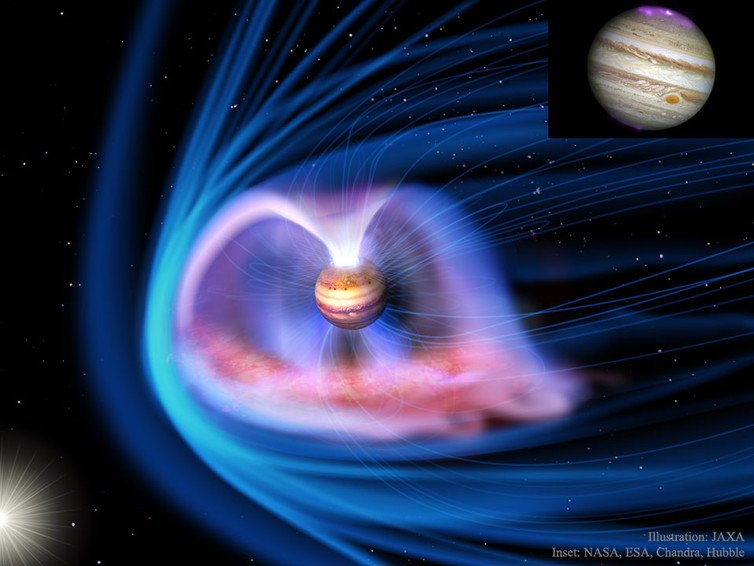The power of Jupiter’s Great Red Spot: enormous storm may be heating the atmosphere

THERE IS AN “energy crisis” on Jupiter. At 800K (527ºC), its upper atmosphere is 600 degrees hotter than expected – a phenomenon also seen on the other giant planets in our solar system. And to make the matter even more perplexing, researchers have now discovered that the region of the atmosphere above Jupiter’s Great Red Spot, a giant storm system, is hundreds of degrees hotter than anywhere else on the planet.
If heat from the sun isn’t enough to produce these temperatures, where does the energy come from? The new observations, published in Nature, suggest that Jupiter’s interior, rather than outside radiation, could be responsible.
Jupiter is a giant gas planet. From Earth we see zones and belts of clouds suspended in the hydrogen-rich atmosphere rotating with respect to each other, with the enormous Great Red Spot in the southern hemisphere. This storm is 22,000km by 12,000km. Though a mere pimple on Jupiter, it would engulf the Earth, and has been raging for hundreds of years, though now it seems to be slowly shrinking.
If you move in towards the planet, the pressure and temperature of the atmosphere increases and eventually becomes metallic hydrogen at a distance up that is about half Jupiter’s radius. Jupiter emits about 60% more power than it receives from sunlight. This is likely due to the helium rain (which doesn’t dissolve in metallic hydrogen) that falls from the top of Jupiter’s highly compressed metallic hydrogen layer towards the centre of the planet, which generates kinetic energy. So we know the inside of Jupiter is extremely hot.
Motions in the metallic hydrogen layer also create Jupiter’s huge magnetic field. This field diverts solar wind around the planet, and the sulphurous material spewing from the volcanoes on Io, one of Jupiter’s moons, dominates the magnetosphere. Because Jupiter rotates rapidly in just under ten hours, the whole magnetosphere is driven by the rotation and it bulges at the equator. Jupiter has its own aurora (northern and southern lights), powered mainly by the magnetosphere. This is seen mainly in the ultraviolet, but with a small contribution (seen in X-rays) from the solar wind.

Jupiter’s magnetosphere and aurora. (Image credit: NASA, ESA, Chandra, Hubble)
As at all planets, the aurora provides a heat source from above. But this energy input is concentrated in the polar regions and cannot explain the heating of the upper atmosphere over all latitudes.
Strong evidence
The new study is based on observations of an ion known as trihydrogen cation, which can be used to estimate the temperature in hydrogen-rich atmospheres. This indicates that the highest temperatures of the planet, by some 800 degrees, are 500 miles straight above the Great Red Spot. The temperatures in the polar regions are also slightly elevated compared with the rest.

Artist’s impression of acoustic waves from Jupiter’s Great Red Spot.(Image credit: Karen Teramura, UH IfA, James O’Donoghue)
Because the Great Red Spot is at lower altitude in Jupiter’s atmosphere, this strongly suggests that energy travelling upwards from the planet’s hot interior is somehow enhanced by the raging storm. The researchers suggest that the storm is producing acoustic waves, which are simply compressions of air, that transport the energy upwards like a huge, high-powered loudspeaker.
But what about the high temperatures at other latitudes, which are still about 600 degrees higher than models would predict? It has been suggested previously that acoustic waves across the planet – produced by turbulent motion in the counter-rotating zones and belts and by smaller more widespread storms – could also be heating the atmosphere. As now there is a direct observation that exactly this happens in the region around the Great Red Spot, it makes sense that it could take place over all latitudes.
Bright regions at the poles result from auroral emissions. Great Red Spot emissions at mid-latitudes can be seen moving under the slit from left to right.
In fact, there are examples on Earth where such energy transfer happens to high altitudes over the Andes mountains, so it seems plausible that something similar could happen on Jupiter. The result could also explain high upper atmosphere temperatures seen at other giant planets and, by analogy, any exoplanets with turbulent atmospheres.
The NASA Juno mission, recently arrived at Jupiter and will tell us more about Jupiter’s interior structure and its aurora, as well as its formation. But we may need to wait for the ESA JUICE mission which arrives in 2030 to tell us more detail about the equatorial regions to help solve Jupiter’s energy crisis for sure.
![]()
Andrew Coates, Professor of Physics, Deputy Director (Solar System) at the Mullard Space Science Laboratory, UCL
This article was originally published on The Conversation. Read the original article.
READ MORE:
- There’s still much to learn by visiting Jupiter
- NASA’S Juno sends first view from Jupiter’s orbit
- Top 10 Aussie space milestones
- This is what it looks like on a comet

